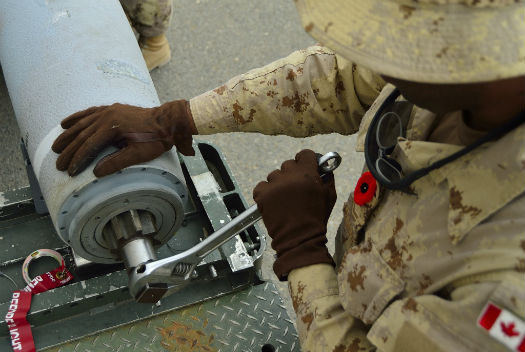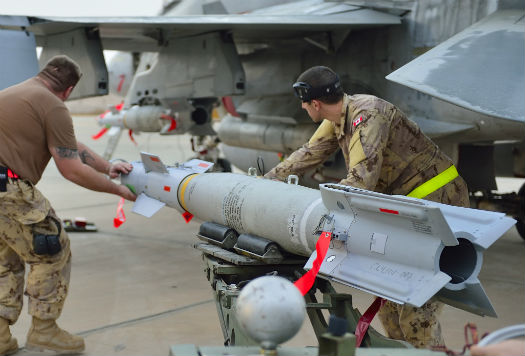RCAF Press Release | November 26, 2014
Estimated reading time 4 minutes, 46 seconds.
A Canadian Armed Forces Ammunition Technician in Kuwait assembles a
500-pound guided bomb that will be mounted on a CF-18 Fighter jet flying
combat missions over Iraq during Operation IMPACT.
Canadian Forces Combat Camera Photo
The sounds of heavy plastic packing cases being opened and socket wrenches winding are carried across an isolated portion of an airbase in Kuwait, as Air Weapons System Technicians (AWS Techs) of the Royal Canadian Air Force unbox and prepare ordnance to be loaded onto CF-188 fighter jets.
The primary job of AWS Techs is to maintain, load and unload the weapons systems of aircraft like the CF-188. As a participant in the Middle East Stabilization Force combatting the Islamic State of Iraq and the Levant (ISIL), Canada has brought along its own air droppable munitions.
With aircraft coming and going at various hours of the day and night, safety is at the forefront of technicians’ minds. Ordnance components are handled with care to prevent damage and accidents as they are brought to the flight line for mounting.
As one technician noted, those driving the bomb loading cart near the aircraft must have a delicate touch on the controls to ensure precise alignment of a weapon under a CF-188’s hard points, which hold the weapons.
“For some new techs, seeing the yellow bands that identify a 500-pound bomb as a live munition can be intimidating at first,” said a crew chief of Air Task Force-Iraq. “But when you finish building the completed weapon, it’s quite revealing to know that it’s not something for the practice range.”
Royal Canadian Air Force ground crew align a bomb as they mount munitions on a
CF-188 Fighter jet prior to the first combat mission over Iraq in support of
Operation IMPACT. Canadian Forces Combat Camera Photo
AWS Techs perform explosives handling, storage and disposal duties at air bases across Canada and overseas. Along with the training they receive over five months at 16 Wing Borden, Ont., with an additional month at 3 Wing Bagotville, Que., for those working with CF-188 munitions, they deploy with a wealth of knowledge and experience.
The advanced nature of modern ordnance, as well as safety protocols, means that weapons components are kept separate and safe until they’re needed. When the fighter detachment requests munitions, technicians set to work in a specially designated location on the base called an “X- area.” With tools in hand, AWS Techs, known as “armourers,” carefully combine the explosive, guidance and stabilisation components into a single weapon.
“It’s warm here and it can get very hot on the ramp while working,” said an armourer. “No one in this trade can get the job done without the rest of the crew, so we are looking out for each other.”
The RCAF employs some of the most accurate and cutting edge munitions in the world. In addition to laser-guided bombs, the RCAF also employs advanced GPS-guided ordnance, first used operationally in Libya during Operation MOBILE in 2011. These weapons have the advantage of cutting through poor weather, such as the ubiquitous sand and dust storms that sweep across the region in the fall and winter.
Having the right munitions along with highly trained personnel ensures that Air Task Force-Iraq will continue to deliver operational excellence.



